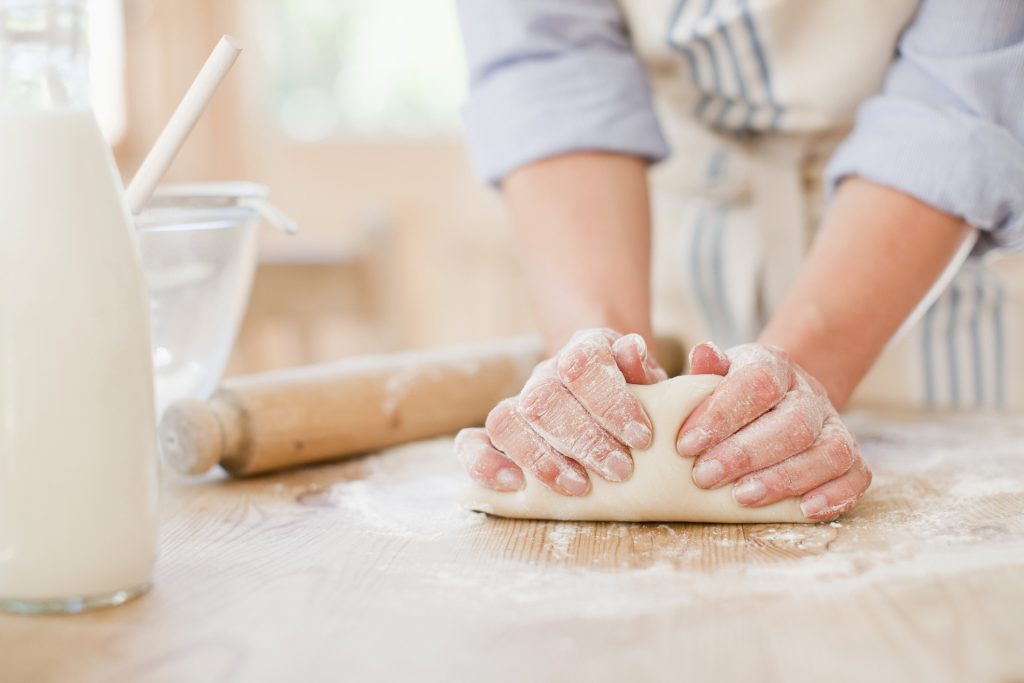
COOKIE TIPS
One cookie dough can make a variety of cookies. For example, after rolling and cutting out sugar cookies, top with sprinkles before baking. Bake others plain and, after baking, dip them halfway into melted chocolate and sprinkle with chopped walnuts. Or, frost the cookies with royal icing and add fancy flourishes to your heart’s content.
When making molded cookies, chill cookie dough overnight or at least a couple of hours before forming the balls and baking them. The dough will be less sticky and easier to work with, plus, more importantly, it keeps the cookies from spreading too much. With most recipes, you can even make the dough ahead of time, freeze it, and then take it out and let it come to room temperature before baking.
Use powdered sugar instead of flour when rolling out sugar cookies. The powdered sugar will add sweetness to the cookies, and you won’t have to worry about adding too much flour.
Cookies will burn less easily if they are baked on a light silver cookie sheet rather than a dark colored sheet.
Use a small plastic bag to cover your hand when greasing the baking sheet. Place your covered hand in the bag, then scoop out some shortening and spread it on the baking sheet. When finished, remove the bag and throw it away.
When it’s time to bake the cookies, place them on the top rack of the oven. If baking two sheets of cookies at one time, place them on different racks at different angles to allow proper air circulation. Switch racks about halfway through the cooking time. When baking cookie bars, place the baking pan in the middle rack of the oven.
If the outer edges of the cookies are getting browned and their centers are not completely cooked, reduce the temperature 15 to 25 degrees. Your cooking time will increase slightly. Increasing the baking temperature would only brown the outer edges faster and the center of the cookie would still be under baked.
Allow cookie sheets to cool in between batches to keep cookie dough from melting and becoming too thin at the edges.
For an easy decoration, add a few chocolate chips, white chocolate chips or M&Ms on top of the cookies just after you’ve removed them from the oven so that they’ll sit on top without being melted into the dough.
Cool the cookies completely before storing or packaging them in airtight containers. Otherwise, the cookies will get soggy from the condensation that will develop.
For soft cookies that have started to dry out, re-soften by adding a piece of bread or a slice of apple to the container they are stored in.
For crispy cookies that have started to get soggy, make them crispy again by placing them on a cookie sheet and heating in the oven at 300 F for 3 or 4 minutes.
CUPCAKE TIPS
If you don’t have enough batter to fill a full muffin tin, fill the remaining empty cups with a little water – this will help the rest of the cupcakes bake more evenly.
After you’ve removed the cupcakes from the oven, only leave them in the pan for a couple minutes and then carefully remove them and place them on a cooling rack to cool completely. If you leave them in the pan, they may continue to bake just from the heat of the pan, and you could end up with cupcakes that are drier than you wanted.
If your frosting is thicker than you’d like it to be, add in milk a little at a time until it reaches the consistency you’re looking for.
No pastry bag for frosting? Use a heavy-duty plastic zipper lock bag with the corner snipped off instead.
To fill a pastry bag with frosting, fit the tip in the bag and then set it inside a pint glass and fold the top of the bag over the sides of the glass. This will make it much easier to spoon in your frosting.
When piping frosting onto cupcakes, there is a right way to do it!
- Hold the pastry bag with one hand firmly holding the twisted end and your other hand near the bottom.
- Hold the bag straight up and down while you move in a circle (either from the outside in, or the inside out depending on the look you’re going for) and once you’re done gently release pressure as you pull the bag up. This will give the cupcake a nice clean peak.
PIE TIPS
Prepare the pie dough the night before and chill overnight in the refrigerator. Roll the dough and bake the next day.
Roll out the dough between two sheets of parchment paper. That way, you’ll just need a sprinkle of flour between the dough and the parchment but not much.
Allow ingredients for the pie filling, such as eggs, butter, and milk, to become room temperature before mixing with other ingredients. Ingredients used to make the pie crust, such as butter and water, should be used while cold.
For a golden brown, flaky pie crust, use a lightweight old-fashioned aluminum pie tin.
No need to buy fancy pie weights. Line your unbaked pie shell with foil and fill with dried beans or rice.
When making a double crust pie, moisten the edge of the bottom crust with water before placing the second crust on top. The moistened edge will help create a good seal once the two crusts are crimped together. Then, for a beautiful presentation, brush the top crust with water and sprinkle with sugar before sliding the pie in the oven to bake.
Prevent the edges of your pie from becoming too brown by covering the edge with foil after the first 15 minutes of baking.



